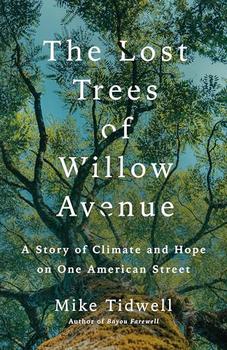Summary | Excerpt | Reviews | Beyond the Book | Readalikes | Genres & Themes | Author Bio

A Story of Climate and Hope on One American Street
by Mike Tidwell
Against the daily background noise of climate change, epic events still astound us each year. They come more frequently now, each with a fresh jolt of warning, a new depth of sadness, and—it feels—a force bordering on evil: the sudden mass bleaching of coral reefs across half the Caribbean Sea; the collapse of Antarctic ice shelves the size of large American cities; the arrival of hurricanes like Katrina.
What happened in the mid-Atlantic starting in 2018 has gotten much less attention despite its historic scale. Nine eastern states and the District of Columbia set records for annual rainfall in 2018, most by wide margins: Delaware, Maryland, Massachusetts, New Jersey, North Carolina, Pennsylvania, Tennessee, Virginia, West Virginia. Maryland got two feet more rain than normal. It was so wet for so long that a big chain reaction was set in motion.
For the big oaks in my neighborhood, it began deep underground, at the foundation of tree life. It began with the roots—and with a mold called phytophthora.
Found naturally in the local soil, phytophthora is a water mold of the oomycetes type, always waiting for the right conditions to expand. It's not a fungus or bacterium, although it's sometimes called "fungus-like" with its own evolutionary tract. Tellingly, the name phytophthora translates from Greek as "plant destroyer." In the summer of 2018, nourished by the soaking deluge, it began latching onto one of its favorite hosts: the hairlike root tips of oak trees.
Phytophthora swarms over these tiny fine roots, feeds on them, and kills them. It severs almost all connection between the tree and the beneficial fungi and minerals in the soil. It limits the flow of water up into the trunk. Though you couldn't see it, by October of that year, thousands of damaged trees in Takoma Park and surrounding neighborhoods were already tapping into emergency supplies of carbohydrates stored in their trunks. As they dropped their autumn leaves that year, many were headed into the last winter of their lives.
* * *
DAVE AND LISA MILLER wound up calling three different arborists to examine their ailing tree. The giant canopy just didn't leaf out properly in the spring of 2019. A third of the tree's branches were naked and dying. Puzzled arborists initially scratched their heads and said some version of "It's an old tree." They didn't know yet that phytophthora had gone wild underground.
By June of that year, at 7128 Willow Avenue, Michele Kurtz and Scott Greenberger noticed their backyard giant was also acting strange. It was a white oak—a tree so regionally common and long-lived that it is the official state tree of Maryland. Throughout June, it shed branches in a torrent. By the end of the month, big swaths of bark began falling off its trunk.
Suddenly, neighborhood LISTSERVs lit up with dire subject lines that summer of 2019. "Is my tree dead?" "So many oaks are turning brown!" "Has anyone found answers?" City officials eventually organized a town hall meeting titled "Disease and Decline: Why Are the Oak Trees Dying?" The crowd was standing room only.
Excerpted from The Lost Trees of Willow Avenue by Mike Tidwell. Copyright © 2025 by Mike Tidwell. Excerpted by permission of St. Martin's Press. All rights reserved. No part of this excerpt may be reproduced or reprinted without permission in writing from the publisher.
There are two kinds of people in the world: those who divide the world into two kinds of people, and those who don'...
Click Here to find out who said this, as well as discovering other famous literary quotes!
Your guide toexceptional books
BookBrowse seeks out and recommends the best in contemporary fiction and nonfiction—books that not only engage and entertain but also deepen our understanding of ourselves and the world around us.